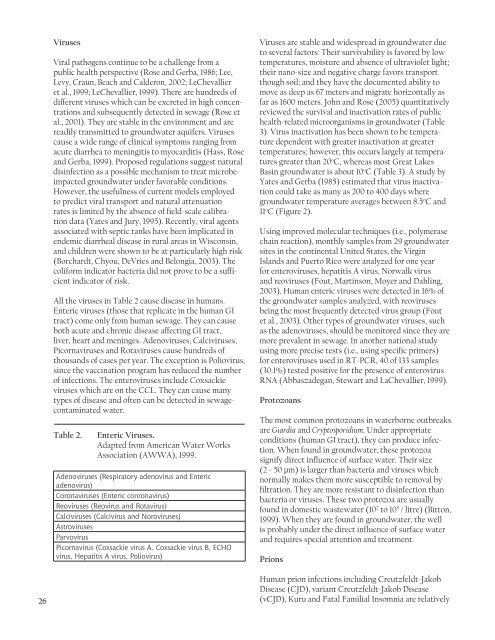Groundwater in the Great Lakes Basin
Groundwater in the Great Lakes Basin
Groundwater in the Great Lakes Basin
You also want an ePaper? Increase the reach of your titles
YUMPU automatically turns print PDFs into web optimized ePapers that Google loves.
Viruses<br />
Viral pathogens cont<strong>in</strong>ue to be a challenge from a<br />
public health perspective (Rose and Gerba, 1986; Lee,<br />
Levy, Craun, Beach and Calderon, 2002; LeChevallier<br />
et al., 1999; LeChevallier, 1999). There are hundreds of<br />
different viruses which can be excreted <strong>in</strong> high concentrations<br />
and subsequently detected <strong>in</strong> sewage (Rose et<br />
al., 2001). They are stable <strong>in</strong> <strong>the</strong> environment and are<br />
readily transmitted to groundwater aquifers. Viruses<br />
cause a wide range of cl<strong>in</strong>ical symptoms rang<strong>in</strong>g from<br />
acute diarrhea to men<strong>in</strong>gitis to myocarditis (Hass, Rose<br />
and Gerba, 1999). Proposed regulations suggest natural<br />
dis<strong>in</strong>fection as a possible mechanism to treat microbeimpacted<br />
groundwater under favorable conditions.<br />
However, <strong>the</strong> usefulness of current models employed<br />
to predict viral transport and natural attenuation<br />
rates is limited by <strong>the</strong> absence of field-scale calibration<br />
data (Yates and Jury, 1995). Recently, viral agents<br />
associated with septic tanks have been implicated <strong>in</strong><br />
endemic diarrheal disease <strong>in</strong> rural areas <strong>in</strong> Wiscons<strong>in</strong>,<br />
and children were shown to be at particularly high risk<br />
(Borchardt, Chyou, DeVries and Belongia, 2003). The<br />
coliform <strong>in</strong>dicator bacteria did not prove to be a sufficient<br />
<strong>in</strong>dicator of risk.<br />
All <strong>the</strong> viruses <strong>in</strong> Table 2 cause disease <strong>in</strong> humans.<br />
Enteric viruses (those that replicate <strong>in</strong> <strong>the</strong> human GI<br />
tract) come only from human sewage. They can cause<br />
both acute and chronic disease affect<strong>in</strong>g GI tract,<br />
liver, heart and men<strong>in</strong>ges. Adenoviruses, Calciviruses,<br />
Picornaviruses and Rotaviruses cause hundreds of<br />
thousands of cases per year. The exception is Poliovirus,<br />
s<strong>in</strong>ce <strong>the</strong> vacc<strong>in</strong>ation program has reduced <strong>the</strong> number<br />
of <strong>in</strong>fections. The enteroviruses <strong>in</strong>clude Coxsackie<br />
viruses which are on <strong>the</strong> CCL. They can cause many<br />
types of disease and often can be detected <strong>in</strong> sewagecontam<strong>in</strong>ated<br />
water.<br />
Table 2.<br />
Enteric Viruses.<br />
Adapted from American Water Works<br />
Association (AWWA), 1999.<br />
Adenoviruses (Respiratory adenovirus and Enteric<br />
adenovirus)<br />
Coronaviruses (Enteric conronavirus)<br />
Reoviruses (Reovirus and Rotavirus)<br />
Calciviruses (Calcivirus and Noroviruses)<br />
Astroviruses<br />
Parvovirus<br />
Picornavirus (Coxsackie virus A, Coxsackie virus B, ECHO<br />
virus, Hepatitis A virus, Poliovirus)<br />
Viruses are stable and widespread <strong>in</strong> groundwater due<br />
to several factors: Their survivability is favored by low<br />
temperatures, moisture and absence of ultraviolet light;<br />
<strong>the</strong>ir nano-size and negative charge favors transport<br />
though soil; and <strong>the</strong>y have <strong>the</strong> documented ability to<br />
move as deep as 67 meters and migrate horizontally as<br />
far as 1600 meters. John and Rose (2005) quantitatively<br />
reviewed <strong>the</strong> survival and <strong>in</strong>activation rates of public<br />
health-related microorganisms <strong>in</strong> groundwater (Table<br />
3). Virus <strong>in</strong>activation has been shown to be temperature<br />
dependent with greater <strong>in</strong>activation at greater<br />
temperatures; however, this occurs largely at temperatures<br />
greater than 20 o C, whereas most <strong>Great</strong> <strong>Lakes</strong><br />
Bas<strong>in</strong> groundwater is about 10 o C (Table 3). A study by<br />
Yates and Gerba (1985) estimated that virus <strong>in</strong>activation<br />
could take as many as 200 to 400 days where<br />
groundwater temperature averages between 8.5 o C and<br />
11 o C (Figure 2).<br />
Us<strong>in</strong>g improved molecular techniques (i.e., polymerase<br />
cha<strong>in</strong> reaction), monthly samples from 29 groundwater<br />
sites <strong>in</strong> <strong>the</strong> cont<strong>in</strong>ental United States, <strong>the</strong> Virg<strong>in</strong><br />
Islands and Puerto Rico were analyzed for one year<br />
for enteroviruses, hepatitis A virus, Norwalk virus<br />
and reoviruses (Fout, Mart<strong>in</strong>son, Moyer and Dahl<strong>in</strong>g,<br />
2003). Human enteric viruses were detected <strong>in</strong> 16% of<br />
<strong>the</strong> groundwater samples analyzed, with reoviruses<br />
be<strong>in</strong>g <strong>the</strong> most frequently detected virus group (Fout<br />
et al., 2003). O<strong>the</strong>r types of groundwater viruses, such<br />
as <strong>the</strong> adenoviruses, should be monitored s<strong>in</strong>ce <strong>the</strong>y are<br />
more prevalent <strong>in</strong> sewage. In ano<strong>the</strong>r national study<br />
us<strong>in</strong>g more precise tests (i.e., us<strong>in</strong>g specific primers)<br />
for enteroviruses used <strong>in</strong> RT-PCR, 40 of 133 samples<br />
(30.1%) tested positive for <strong>the</strong> presence of enterovirus<br />
RNA (Abbaszadegan, Stewart and LaChevallier, 1999).<br />
Protozoans<br />
The most common protozoans <strong>in</strong> waterborne outbreaks<br />
are Giardia and Cryptosporidium. Under appropriate<br />
conditions (human GI tract), <strong>the</strong>y can produce <strong>in</strong>fection.<br />
When found <strong>in</strong> groundwater, <strong>the</strong>se protozoa<br />
signify direct <strong>in</strong>fluence of surface water. Their size<br />
(2 - 50 µm) is larger than bacteria and viruses which<br />
normally makes <strong>the</strong>m more susceptible to removal by<br />
filtration. They are more resistant to dis<strong>in</strong>fection than<br />
bacteria or viruses. These two protozoa are usually<br />
found <strong>in</strong> domestic wastewater (10 2 to 10 5 / litre) (Bitton,<br />
1999). When <strong>the</strong>y are found <strong>in</strong> groundwater, <strong>the</strong> well<br />
is probably under <strong>the</strong> direct <strong>in</strong>fluence of surface water<br />
and requires special attention and treatment.<br />
Prions<br />
26<br />
Human prion <strong>in</strong>fections <strong>in</strong>clud<strong>in</strong>g Creutzfeldt-Jakob<br />
Disease (CJD), variant Creutzfeldt-Jakob Disease<br />
(vCJD), Kuru and Fatal Familial Insomnia are relatively

















